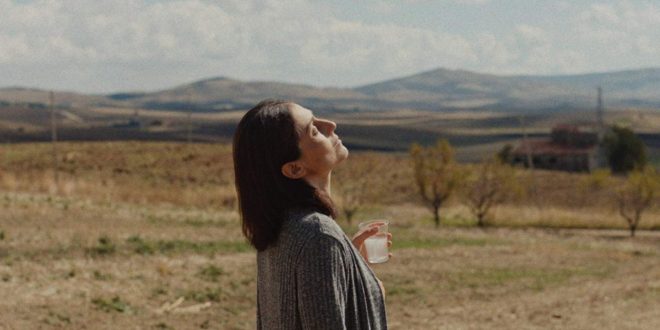Horror is, first and foremost, a genre defined by its agenda. Whether the impression of horror manifests as fear, dread, revulsion, or unease, the project has to do its job. More often than not, these duties are performed by the ever-evolving bouquet of blood and gore special effects. We see the viscera of a victim and remember that we, too, have viscera. We remember our own meat and imagine the same slash and burn tactics being acted upon it. This is why some horror fans draw the property lines of the genre with thick, goopy, corn syrup blood. If it doesn’t bleed, it’s not horror.
In watching Writer/Director Sara Summa’s bold debut feature film, The Last To See Them, I felt compelled to reach deeper into myself as the film played on, past my pumping heart, churning entrails, and complex cobwebs of veins to find something more precious, potent and devastating to see in the film’s victims: life itself.

This is not a film for fans of Terrifier (2017 – read our review here) or Hatchet (2006 – read our retro review here). The Last To See Them is precisely paced to ask a bold question about the nature of violence and about the necessity of that violence’s depiction. “We don’t need to see red,” the film seems to say, “to feel dread.” As a lover of Italian giallo, I leaped at the chance to review a new Italian language horror film. When I landed, however, I was greeted by something truly and beautifully unique.
The Last To See Them opens lazily, rolling down a winding road in the baking Italian sun, with a title card informing us that a family, the Duratis, was killed during a robbery. The children died in their beds. The parents died at the dinner table, tied to their chairs. Stark white letters against postcard perfect Italian roads. In the intricate game of cinematic chess that is this film, a title card such as this is Summa’s opening gambit. What follows is one of the most inventive, challenging genre explorations that I’ve seen in some time.

We leave the road and enter a day in the life of the Durati family, meeting each of them as they prepare for a relative’s wedding. Dora, the daughter (newcomer Barbara Verrastro), races around the house. She navigates her teenage dating life: making bridesmaids’ dresses, teaching a short-notice baking lesson, and cooking dinner for her family.
Her father, Renzo (newcomer Canio Lancellotti), bears his own crosses: caring for his ailing wife, Alice (newcomer Donatella Viola), negotiating a new life insurance policy, and disciplining his son, Matteo (newcomer Pasquale Lioi).
Each family member receives the camera’s benediction as we learn of their private struggles, dreams, hopes, fears, and preoccupations. Summa’s chess pieces continue to move as the views puts each new discovery into the context of this family’s slowly approaching end. Matteo works on a carved wooden chest, a wedding present for the next day. Dora teaches a neighbor girl to make a ricotta pie and promises to teach her another recipe later. Alice wrestles with whether to tell her children about an impending operation now or at some better time. Renzo tells the insurance agent that he will need time to think about the new policy, and will get back to him soon with an answer.

The next day. Later. Some better time. Soon. These phrases we say each day crash to the floor with the weight of gunshots as we remember that this day is all the Duratis have left. Summa reminds us of this somber fact by occasionally returning to the drifting road where we first learned of their fates. The quotidian set pieces of Italian neorealist cinema pass by with the grandeur of Bible verses as we sit by, helplessly along for the ride, rocketing towards the end of the Durati’s world.
Rather than saw a woman in half or slash at the strings of a violin to bring us to heel, Sara Summa intelligently allows the stark realism of her actors, all of whom have never acted before, to horrify us with the dramatic irony of their fate. No ghost or gunshot outpaces the grim realization that the title, The Last To See Them, refers us to. We are the last ones to see them.
In its simplicity, this film begs for interpretations great and small. The now pointless machinations of the Durati family could be stand-ins for the quibbling of politicians on our dying planet, the sound and fury of all human existence, signifying nothing in the face of its end, the rhetorical flourish about the importance of grounded, sympathetic characters in horror cinema, or even our own “single sand grain on a beach” lives. The Last To See Them exists in the tradition of Gus Van Sant’s Elephant (2003), Michael Haneke’s Funny Games (1997 – read our retro review here), and even Vittorio De Sica’s The Bicycle Thieves (1948). It does not ask why. It only knows what it knows and leaves the guessing up to God.

The mounting, cumulative tension of every knock on the door, every visitor and musical cue brings the audience to the creaking point of collapse and never truly lets up.
It is absolutely baffling to me that The Last to See Them is Sara Summa’s first feature length project, as the film feels conducted by a master at work. Each shot and line of dialogue work in perfect unison, a finely tuned engine in a car leisurely making its way towards the Durati farmhouse, to hastily, and, as is the case with all real violence, anti-climactically punctuate their last brief scene on this planet.
 PopHorror Let's Get Scared
PopHorror Let's Get Scared




